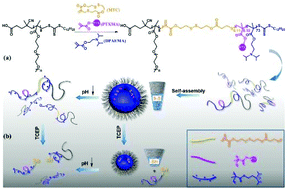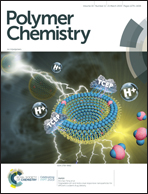Degradable pH and redox dual responsive nanoparticles for efficient covalent drug delivery†
Abstract
Examples of successful therapies using macromolecular prodrugs to which the drug is linked via covalent bonds have been reported; however, there are safety concerns which render them disfavourable for clinical applications. Therefore, it is essential to reassess this class of drugs by designing compounds that combine covalent linking with reducible linkers. Herein, the hydrophobic drug paclitaxel was modified into a polymerizable monomer and subsequently copolymerized with pH-sensitive monomers and redox-sensitive disulfide-based cyclic monomers. The resulting diblock copolymer can self-assemble into vesicles incorporating the hydrophobic drug PTX into the vesicle walls. On decreasing the pH value, the size of the vesicular drug container varied with the change in the hydrophobicity–hydrophilicity balance. Treatment with reducing agents mediated the disassembly of the aggregates facilitating the release of the drug moiety. Furthermore, in vitro cell experiments showed that the nanoparticles exhibited cytotoxicity, indicating that they have potential as a drug delivery system for anti-cancer treatments.



 Please wait while we load your content...
Please wait while we load your content...